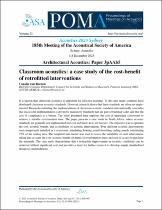 ResearchSpace
ResearchSpace
Classroom acoustics: A case study of the cost-benefit of retrofitted interventions
JavaScript is disabled for your browser. Some features of this site may not work without it.
- ResearchSpace
- →
- Research Publications/Outputs
- →
- Conference Publications
- →
- View Item
| dc.contributor.author |
Van Reenen, Coralie A

|
|
| dc.date.accessioned | 2024-02-06T12:53:21Z | |
| dc.date.available | 2024-02-06T12:53:21Z | |
| dc.date.issued | 2023-12 | |
| dc.identifier.citation | Van Reenen, C.A. 2023. Classroom acoustics: A case study of the cost-benefit of retrofitted interventions. http://hdl.handle.net/10204/13578 . | en_ZA |
| dc.identifier.uri | https://doi.org/10.1121/2.0001807 | |
| dc.identifier.uri | http://hdl.handle.net/10204/13578 | |
| dc.description.abstract | It is known that classroom acoustics is important for effective learning. To this end, many countries have developed classroom acoustics standards. However, research shows that these standards are often not implemented. Research evaluating the implementation of classroom acoustic standards internationally concludes that successful implementation is driven by mandatory standards that are part of building codes and that the cost of compliance is a barrier. The study presented here explores the cost of upgrading classrooms to achieve a suitable reverberation time. The paper presents a case study in South Africa, where acoustic standards are generally not implemented and cost and know-how are barriers. The objective was to optimise the cost, acoustic benefit, and accessibility of acoustic interventions. Four different acoustic interventions were temporarily installed in a classroom, simulating floating sound-absorbing ceiling panels constituting 25% of the ceiling area. The weighted sum model was used to assess the suitability of each intervention, taking into account the cost, acoustic benefit (in terms of reverberation time) and ease of access to purchase the materials. The case study demonstrates that a noticeable improvement in acoustic conditions can be achieved without significant cost and provides a basis for further research to develop simple standardised design recommendations. | en_US |
| dc.format | Fulltext | en_US |
| dc.language.iso | en | en_US |
| dc.relation.uri | https://pubs.aip.org/asa/poma/article/52/1/015001/2930327/Classroom-acoustics-a-case-study-of-the-cost | en_US |
| dc.source | 185th Meeting of the Acoustical Society of America, Sydney, Australia, 4-8 December 2023 | en_US |
| dc.subject | Classroom acoustics | en_US |
| dc.subject | Classroom acoustic standards | en_US |
| dc.subject | Retrofitted interventions | en_US |
| dc.title | Classroom acoustics: A case study of the cost-benefit of retrofitted interventions | en_US |
| dc.type | Conference Presentation | en_US |
| dc.description.pages | 12 | en_US |
| dc.description.note | © 2023 Acoustical Society of America. Paper presented at the 185th Meeting of the Acoustical Society of America, Sydney, Australia, 4-8 December 2023 | en_US |
| dc.description.cluster | Smart Places | en_US |
| dc.description.impactarea | Infrastructure Innovation | en_US |
| dc.identifier.apacitation | Van Reenen, C. A. (2023). Classroom acoustics: A case study of the cost-benefit of retrofitted interventions. http://hdl.handle.net/10204/13578 | en_ZA |
| dc.identifier.chicagocitation | Van Reenen, Coralie A. "Classroom acoustics: A case study of the cost-benefit of retrofitted interventions." <i>185th Meeting of the Acoustical Society of America, Sydney, Australia, 4-8 December 2023</i> (2023): http://hdl.handle.net/10204/13578 | en_ZA |
| dc.identifier.vancouvercitation | Van Reenen CA, Classroom acoustics: A case study of the cost-benefit of retrofitted interventions; 2023. http://hdl.handle.net/10204/13578 . | en_ZA |
| dc.identifier.ris | TY - Conference Presentation AU - Van Reenen, Coralie A AB - It is known that classroom acoustics is important for effective learning. To this end, many countries have developed classroom acoustics standards. However, research shows that these standards are often not implemented. Research evaluating the implementation of classroom acoustic standards internationally concludes that successful implementation is driven by mandatory standards that are part of building codes and that the cost of compliance is a barrier. The study presented here explores the cost of upgrading classrooms to achieve a suitable reverberation time. The paper presents a case study in South Africa, where acoustic standards are generally not implemented and cost and know-how are barriers. The objective was to optimise the cost, acoustic benefit, and accessibility of acoustic interventions. Four different acoustic interventions were temporarily installed in a classroom, simulating floating sound-absorbing ceiling panels constituting 25% of the ceiling area. The weighted sum model was used to assess the suitability of each intervention, taking into account the cost, acoustic benefit (in terms of reverberation time) and ease of access to purchase the materials. The case study demonstrates that a noticeable improvement in acoustic conditions can be achieved without significant cost and provides a basis for further research to develop simple standardised design recommendations. DA - 2023-12 DB - ResearchSpace DP - CSIR J1 - 185th Meeting of the Acoustical Society of America, Sydney, Australia, 4-8 December 2023 KW - Classroom acoustics KW - Classroom acoustic standards KW - Retrofitted interventions LK - https://researchspace.csir.co.za PY - 2023 T1 - Classroom acoustics: A case study of the cost-benefit of retrofitted interventions TI - Classroom acoustics: A case study of the cost-benefit of retrofitted interventions UR - http://hdl.handle.net/10204/13578 ER - | en_ZA |
| dc.identifier.worklist | 27471 | en_US |





